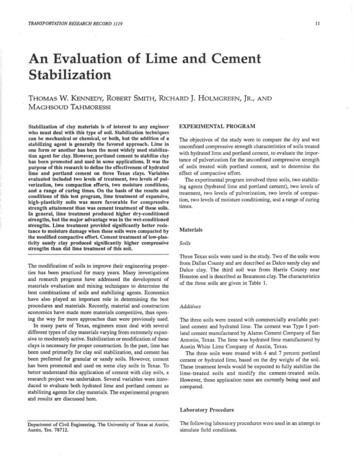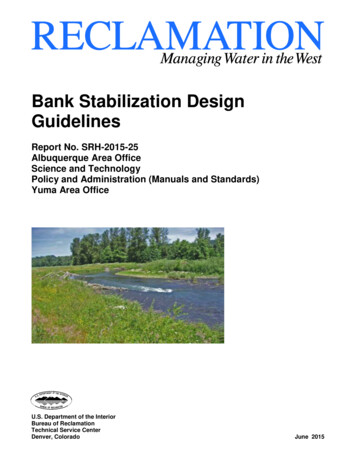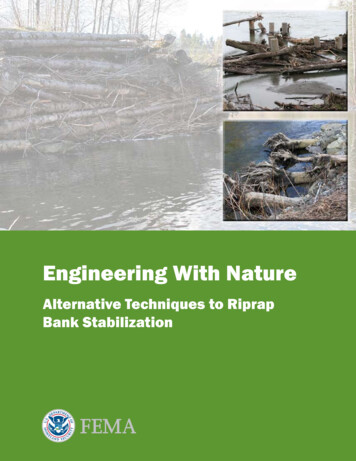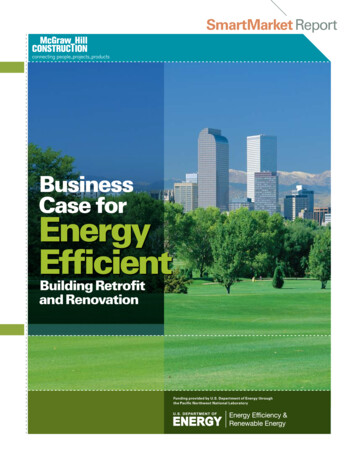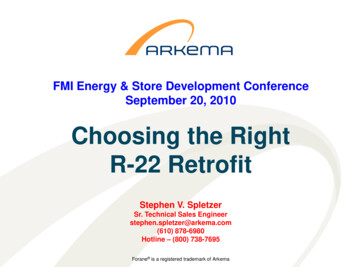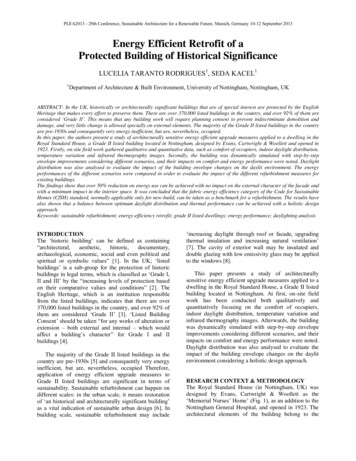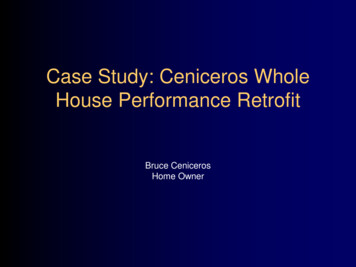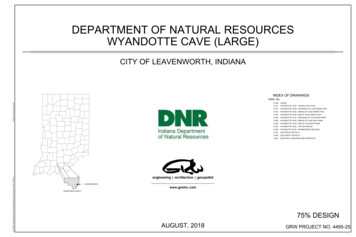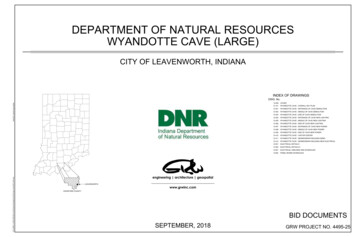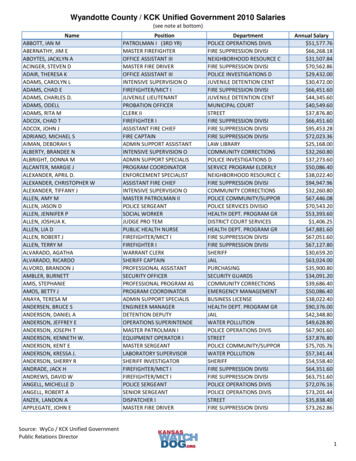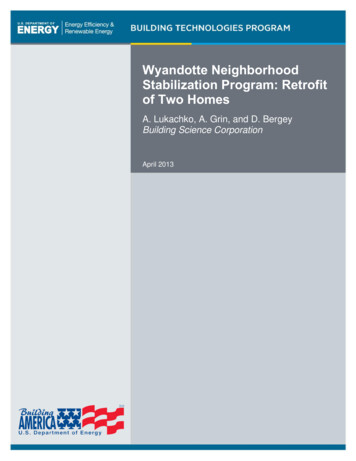
Transcription
Wyandotte NeighborhoodStabilization Program: Retrofitof Two HomesA. Lukachko, A. Grin, and D. BergeyBuilding Science CorporationApril 2013
NOTICEThis report was prepared as an account of work sponsored by an agency of theUnited States government. Neither the United States government nor any agencythereof, nor any of their employees, subcontractors, or affiliated partners makes anywarranty, express or implied, or assumes any legal liability or responsibility for theaccuracy, completeness, or usefulness of any information, apparatus, product, orprocess disclosed, or represents that its use would not infringe privately owned rights.Reference herein to any specific commercial product, process, or service by tradename, trademark, manufacturer, or otherwise does not necessarily constitute or implyits endorsement, recommendation, or favoring by the United States government orany agency thereof. The views and opinions of authors expressed herein do notnecessarily state or reflect those of the United States government or any agencythereof.Available electronically at http://www.osti.gov/bridgeAvailable for a processing fee to U.S. Department of Energyand its contractors, in paper, from:U.S. Department of EnergyOffice of Scientific and Technical InformationP.O. Box 62Oak Ridge, TN 37831-0062phone: 865.576.8401fax: 865.576.5728email: mailto:reports@adonis.osti.govAvailable for sale to the public, in paper, from:U.S. Department of CommerceNational Technical Information Service5285 Port Royal RoadSpringfield, VA 22161phone: 800.553.6847fax: 703.605.6900email: orders@ntis.fedworld.govonline ordering: http://www.ntis.gov/ordering.htmPrinted on paper containing at least 50% wastepaper, including 20% postconsumer waste
Wyandotte Neighborhood Stabilization Program: Retrofit of TwoHomesPrepared for:The National Renewable Energy LaboratoryOn behalf of the U.S. Department of Energy’s Building America ProgramOffice of Energy Efficiency and Renewable Energy15013 Denver West ParkwayGolden, CO 80401NREL Contract No. DE-AC36-08GO28308Prepared by:A. Lukachko, A. Grin, and D. BergeyBuilding Science Corporation30 Forest StreetSomerville, MA 02143NREL Technical Monitor: Cheryn MetzgerPrepared under Subcontract No. KNDJ-0-40337-00April 2013iii
[This page left blank]iv
ContentsList of Figures . viiList of Tables . viiDefinitions . viiiExecutive Summary . ix1 Introduction . 11.1 Project Background .11.2 Relevance to Building America Goals .41.3 Project Location .52Mathematical and Modeling Methods . 72.1 Energy Modeling Methods .73Experimental Methods . 83.1 Testing Methods.83.2 Collection of Utility Bill Data.84Results . 104.1 Final Energy Efficient Technology Package .104.1.1 Enclosure Specifications .114.1.2 Mechanical Specifications .144.2 Energy Analysis Results—Cost Effectiveness of the Energy Efficiency Measures.164.2.1 Background and Cost Information .164.2.2 BEopt Modeling Results .184.3 Airtightness Testing Results .225Discussion. 235.1 General .235.2 Documentation .235.3 Builder Selection and Training .245.4 Foundations .245.5 Insulation and Air Sealing .255.6 HVAC Installation .265.7 Lighting and Appliances .265.8 Sales and Marketing.265.9 Purchase Price .265.10Home Buyer Education .276Conclusions . 286.1 Discussion of Research Questions .286.2 Future Development for Higher Performance Levels .296.3 Gaps in Existing Measure Guidelines .296.3.1 Quality Management Strategies .306.3.2 Recommendations for Future Measure Guidelines.306.3.3 Ground Source Heat Pumps for Cold Climate Homes .306.3.4 Heat Recovery Ventilator and Energy Recovery Ventilator Systems for ColdClimates .307 Acknowledgments . 31References . 32Appendices . 34Appendix A: MSHDA Wyandotte, Michigan NSP2 Target Areas .35Appendix B: Wyandotte, Michigan NSP2 Initial Energy Analysis (November 9, 2010) .36Appendix C: House Plans for Wyandotte NSP2 Pilot Community .41v
Appendix D: Site Visit Reports .44Appendix E: Press Reports .8 Team Contact Information .96vi
List of FiguresFigure 1. Typical existing houses in the NSP2 neighborhood . 2Figure 2. Proposed NSP2 allocations by eligible use (MSHDA 2009) . 5Figure 3. Wyandotte, Michigan relative to Detroit . 6Figure 4. Photograph of Cedar 1 near completion . 11Figure 5: Repair work on Cedar 2 foundation . 13Figure 6. Photograph of a well operation for a GSHP system in the NSP2 neighborhood . 15Figure 7. Central fan integrated supply ventilation schematic . 16Figure 8. Preliminary BEopt parametric study for Wyandotte NSP2 retrofit test home . 19Figure 9. Preliminary BEopt cost study for Wyandotte NSP2 retrofit test home . 19Figure 10. Final BEopt energy analysis results by end use . 20Figure 11. Final BEopt cost study . 21Figure 12. Example of floor framing plan with mechanical layout. 23Figure 13. Spray foam installation in conditioned crawlspace at Cedar 1. 24Figure 14. Typical ductwork sealing at takeoff from trunk; elbow to the site is sealed . 26Figure 15. 247 Walnut parametric results graph . 40Unless otherwise noted, all figures were created by the BSC team.List of TablesTable 1. Wyandotte NSP2 Test Houses . 2Table 2. Summary of Wyandotte NSP2 Energy Efficiency Retrofit Package Components . 3Table 3. Wyandotte NSP2 Properties by Bid Package . 6Table 4. Wyandotte, Michigan NSP2 Retrofit Enclosure Specifications . 11Table 5. Wyandotte, Michigan NSP2 Mechanical System Specifications . 14Table 6: Cost Information Summary Table . 17Table 7. Wyandotte NSP2 Enclosure Performance Testing . 22Table 8. Common Points of Air Leakage . 25Table 9. Construction Cost and List Price for Wyandotte NSP2 Retrofit Homes . 27Table 10: Basic dimensions and areas for 247 Walnut . 38Table 11. Building Energy Specifications. 39Table 12. Simulation Results for 247 Walnut . 39Table 13. Industry Team Member Contact Information . 96Unless otherwise noted, all tables were created by the BSC teamvii
DefinitionsACCAAir Conditioning Contractors of AmericaAMIArea Median IncomeASHPAir Source Heat PumpBABuilding America Program. More information about BA can be found atwww.buildingamerica.govBEoptBuilding Energy Optimization Program – House energy simulation program andprimary analysis tool for Building America homes.BSCBuilding Science Corporation. More information about BSC can be found atwww.buildingscience.comccSPFClosed-cell Spray Polyurethane FoamocSPFOpen-cell Spray Polyurethane FoamCFISCentral Fan Integrated Supply, a mechanical ventilation design. Moreinformation about CFIS ventilation can be found at www.fancycler.com/EFEnergy FactorFF PICFoil Faced PolyisocyanurateGSHPGround Source Heat PumpHSPHouse Simulation Protocol – Guideline document that defines the benchmark, astandard calculation by which the retrofit construction test house is compared.IECCInternational Energy Conservation Code. More information can be found atwww.energycodes.gov/MSHDAMichigan State Housing Development AuthorityNRELNational Renewable Energy Labs. More information about NREL can be foundat www.nrel.gov/NSP2Neighborhood Stabilization Program 2 (NSP2) more information can be found grams/neighborhoodspg/arrafactsheet.cfmo.c.On CenterOSBOriented Strand BoardpcfPounds per cubic footocSPFOpen-cell Spray Polyurethane FoamSEERSeasonal Energy Efficiency RatioSIRSavings to Investment Ratioviii
Executive SummaryThe Wyandotte Neighborhood Stabilization Program 2 (NSP2) project is building 20 new housesand retrofit 20 existing houses in Wyandotte, Michigan. This report details the retrofit of twoexisting houses in the program. Wyandotte is part of a Michigan State Housing DevelopmentAuthority (MSHDA)-led consortium that is funded by the U.S. Department of Housing andUrban Development (HUD) under the NSP2 program. The City of Wyandotte has also beenawarded U.S. Department of Energy (DOE) energy efficiency and conservation block grant(EE&CBG) funds that are being used to develop a district ground source heat pump (GSHP)system to service the project.This report examines the energy efficiency recommendations for retrofit construction at thesehomes. The report will be of interest to anyone planning an affordable, high performance retrofitof an existing home in a cold climate zone. Information from this report will also be useful toretrofit or weatherization program staff, as some of the proposed retrofit solutions will apply to awide range of projects.In this project, the DOE Building America team Building Science Corporation (BSC) addressedthe following research goals and questions on the two test houses:1. Does the ccSPF retrofit insulation strategy provide the planned level of airtightness in theexisting building frame?2. Where insulating sheathing is used with replacement windows, can water managementdetails for insulating sheathing be cost effectively executed by the construction team?3. Does the total project cost fall within the project requirements and deliver higher thanexpected energy performance?4. Is the sizing method for the GSHP accurate for small houses with high thermal resistanceenclosures?5. Can the GSHP unit be reduced in size to accommodate additional homes on the samewell?Results from the first complete house suggest that the technology package employed (whichincludes spray foam insulation and insulation sheathing) does meet the specific whole housewater, air, and thermal control performance specification established for this project and theproject’s affordability goals. The technology specification for the existing NSP2 houses hasachieved an estimated 42% reduction in whole house energy use relative to the Building AmericaBenchmark. Monitoring of the GSHP system has been recommended for a future project. Futurecollection of utility bill data is planned.ix
1 IntroductionThis research report describes work conducted by Building Science Corporation (BSC), a U.S.Department of Energy (DOE) Building America research team and describes a project to retrofittwo single family homes as part of the Wyandotte, Michigan Neighborhood Stabilization Project2 (NSP2).Through the test home evaluation in Wyandotte, BSC has acquired important information aboutthe construction and performance of the energy efficient technology packages designed for U.S.Department of Housing and Urban Design (HUD) NSP2 retrofit projects in a cold climate. Thisresearch addresses the following gaps and barriers: Affordable high performance enclosure assemblies Complete high performance technology packages for affordable homes.Through this work, BSC has also collected information about the cost and implementation issueswith high R-value assemblies in existing buildings. In the future, BSC will use this project tocollect measured energy use data for affordable high performance retrofits.1.1 Project BackgroundThe Wyandotte NSP2 project is building 20 new houses and retrofit 20 existing houses inWyandotte, Michigan. Wyandotte is part of a Michigan State Housing Development Authorityled consortium that is funded by HUD under the NSP2 program. 1 The City of Wyandotte hasalso been awarded DOE energy efficiency and conservation block grant (EE&CBG) funds thatare being used to develop a district GSHP system to service the project. 2The first two existing houses constructed in this NSP2 project were selected as part of theBuilding America research project, and are shown in Table 1 below. Both houses were poorlymaintained and near the end of their useful service life. The retrofit work for these housesincluded complete interior renovation and upgrades to the enclosure and mechanical systems. Itis expected that this investment has significantly extended the service life of these buildings.1Information about the MSHDA program can be found here: -,00.html2More information about the DOE EE&CBG grant can be found here: http://www.energy.gov/9068.htm1
Table 1. Wyandotte NSP2 Test HousesCedar 11453 ft2 two-story single-family detached houseCedar 21327 ft2 one-and-a-half-story single-family detached houseFigure 1 below shows typical houses in the NSP2 neighborhood.Figure 1. Typical existing houses in the NSP2 neighborhoodResearch work undertaken by Building Science Corporation on this project is connected toprevious research work on high R-value retrofit enclosures, the effectiveness of ventilationsystems, and other whole house energy efficiency retrofit packages for affordable housing asdescribed below.High performance retrofit wall assemblies have been studied and reported on by BSC [Pettit2009; BSC 2011-2, 2011-3] and research work on this technology continues. Findings indicate2
that an existing wood frame wall can be effectively retrofit from either the exterior (with boardfoam insulation or spray foam insulation) or from the interior (with a variety of insulationmaterials). A recent BSC paper has summarized the experience with these efforts [Ueno 2010]and identified water management and air tightness issues as major concerns for both methods.For air sealing, complicated building geometry will be identified early and particular attentionwill be paid to the insulation and air barrier retrofit in these areas. Spray foam insulation appliedfrom either the interior or the exterior will be an initial system for consideration based on pastsuccess. Simplification of the existing house geometry through use of a “chainsaw retrofit” willalso be considered [Orr 1987]. Research work on this project will
The Wyandotte Neighborhood Stabilization Program 2 (NSP2) project is building 20 new houses and retrofit 20 existing houses in Wyandotte, Michigan. This report details the retrofit of two existing houses in the program. Wyandotte
